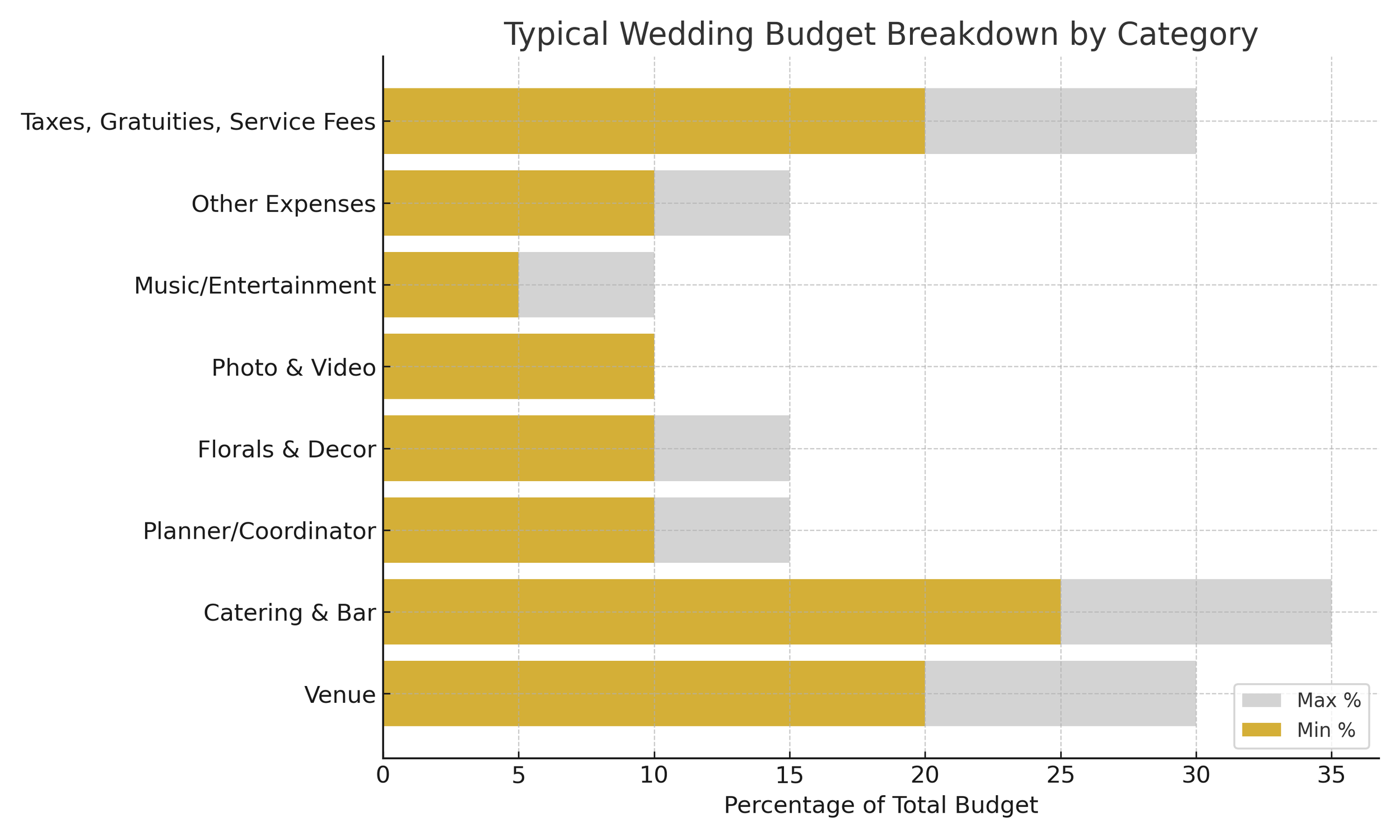bride’s guide to: how much a Wedding Really Costs
(and How to Build a Budget That Works for You)
You're newly engaged. Your first instinct is to do a quick Google search to get a sense of the cost of this wedding.
And there it is—in bold letters:
"The average wedding in the U.S. costs $35,000."
Cue the sigh of relief… until you start researching venues and find that $35K barely covers your food and beverage minimum.
... Let's talk about it.
Disclaimer: Don't get me wrong! $35,000 is a lot of money. I'd love it if $35k popped up in my account right now!
Where Did That $35K Number Even Come From?
Many popular wedding blogs do a yearly wrap-up that includes the average cost of a U.S. wedding and other demographics.
It's no secret that the "average" wedding cost listed online doesn't paint the whole picture, and it most certainly doesn't reflect the carefully curated Pinterest boards you've been fawning over for a while now. While it may reflect a nationwide average, it doesn't account for location, guest count, or the quality and professionalism of your vendor team.
Here's the truth:
In many cities, $35,000 is a minimum food and beverage budget, not a full wedding budget. I am not talking about major cities, but most U.S. cities.
That number doesn't include a planner, floral design, entertainment, rentals, stationery, wedding cake/dessert, wedding attire, hair and makeup, or the cost of a venue rental that doesn't offer in-house services, just to name a few budget categories. It's a misleading benchmark that often sets couples up for frustration, sticker shock, or the belief that vendors are overcharging.
The issue isn't with budget-conscious weddings; it's with how the wedding industry talks about money in the first place.
Let's make room for honest conversations, regardless of your guest count or aesthetic, so you have a clear picture of what you will likely spend.
Why the Numbers Vary So Much
Weddings aren't one-size-fits-all. A wedding for 40 people at a family cabin looks very different than a 200-person ballroom celebration. One isn't better than the other, but it comes with different costs. In all honesty, choosing a small cabin wedding doesn't save as much money as you think. The cost is actually pretty similar; the allocations of your budget just change.
When we're talking about full wedding budgets that include professional vendors, full meals, guest experience, and design details, here's a realistic breakdown:
These are general numbers and vendor ideas. You will allocate your budget based on what is most important to you.
A thoughtfully curated wedding for 100–150 guests typically starts at $75,000–$150,000+, depending on the location and your style preferences.
Why Weddings Cost More Than You Think
If you've ever said, "It's like prices go up the second you say the word wedding," you're not alone.
But the reality isn't that vendors are "scamming" you; they aren’t looking for a quick “come-up” at your expense. It’s plain and simple: Weddings come with a higher level of risk, labor, customization, and accountability than other types of events.
Here's what couples don't always see:
There's no second chance. Your team has one shot to get it right, no do-overs, and minimal margin for error. The stakes are higher since you are spending your hard-earned money, and not a corporation with a corporate card that can have a do-over and learn from the missed opportunities.
Vendors invest 30–60+ hours per client. You may see them for one day, but they've been working for months. **Planners can spend well over 360 hours on your wedding alone**
It's highly personalized work: designing your stationery and event branding to sourcing the right seasonal florals and vendors who authentically tell your love story. Yes, weddings have the same general framework, but aren't plug-and-play events.
Professional vendors are licensed, insured, and experienced. For good reason, peace of mind is built into the price.
Planning Tips for a Realistic Wedding Budget
No matter your style or price point, here are some tips that apply across the board:
1. Start with Your Priorities
Do you care most about great food, an incredible atmosphere, or stunning photos? Build your budget around what matters most to you, and scale back on things you care less about.
2. Know What Affects Your Budget
The biggest driver of cost is your guest count. Let me repeat it! Your guest count is the biggest driver of your budget. Every guest = another chair, place setting, meal, drinks, favors, escort card, and more. More people = more money, plain and simple.
Why Your Guest List Drives Everything?
Your guest list isn't just a number; it's the foundation of your wedding budget and event design. Every decision you make is based on the number of people you're hosting.
Here's what increases when your guest count grows:
Catering Costs: More guests mean more meals, more people for soft drinks and alcohol, more event staff, and sometimes more kitchen equipment.
Rentals: Each guest needs a chair, a place setting, a linen napkin, flatware, glassware, and a charger plate, to name a few rental items.
Stationery & Postage: Every guest adds to your save-the-date, invitation suite, and RSVP count (and yes, postage too).
Transportation: Shuttle service, valet, and parking logistics get more complicated with larger groups.
Favors & Welcome Bags: Multiply even a $10 favor across 200 guests, and that's a $2,000 line item.
Larger Venue Needs: Not all venues can comfortably accommodate a big crowd, and larger venues often have higher minimums or rental fees. Does your venue accommodate your guest list for both your ceremony and reception? If it doesn’t, you have to add an additional fee to host both events. Even churches require payment or a donation in place of payment.
Staffing & Security: More people require more servers, bartenders, restrooms, coat check attendants, and sometimes extra security staff.
📌 Pro tip: Trimming 25 guests could easily save you $5,000–$20,000. Guestlist management is key when adjusting your wedding budget.
3. Get Clear on Fixed Costs
Items like tenting, restrooms (for private estates), additional staffing, or venue-specific rules (e.g., must use their rental vendor) can add thousands to your budget. Always ask for all the numbers, not just base fees.
4. Be Transparent with Your Planner
When couples say, "We don't want to spend more than $X," I take that seriously. But I also help you understand what your budget can support so you're not disappointed halfway through the process. It's all about building a plan that aligns with your expectations.
This is where having a planner who specializes in strategic planning comes in. I focus on what is most important to you and provide vendor and venue options that support this to get you as close to your initial vision as possible.
For Budget-Conscious Couples - before you leave a comment saying a wedding is only one day.
Let me be clear, this isn't about shaming couples who want to keep costs down. You can absolutely plan a beautiful, heartfelt celebration at a lower price point. But I don't want you to feel blindsided or misled when reality doesn't match what you read online.
Don't be shy! Just because a vendor doesn't have their pricing listed on their website doesn't mean they are outside of your budget. Chances are, they have many options that accommodate various budgets and don't want to scare you off when you see their price. And if they are outside of your budget, that’s okay. No need to be discouraged; they likely have a list of vendor friends within your budget and can refer you to them.
Let's Keep the Conversation Going!
This blog was written to open up honest, helpful conversations around wedding transparency, which wedding professionals need to do better with.
No matter your budget, you deserve real support, honest advice, and a planning experience that feels intentional rather than overwhelming.
What questions do you have about creating a wedding budget?
Have you run into pricing surprises during your planning process?
Leave a comment below; I'd love to hear your thoughts.




